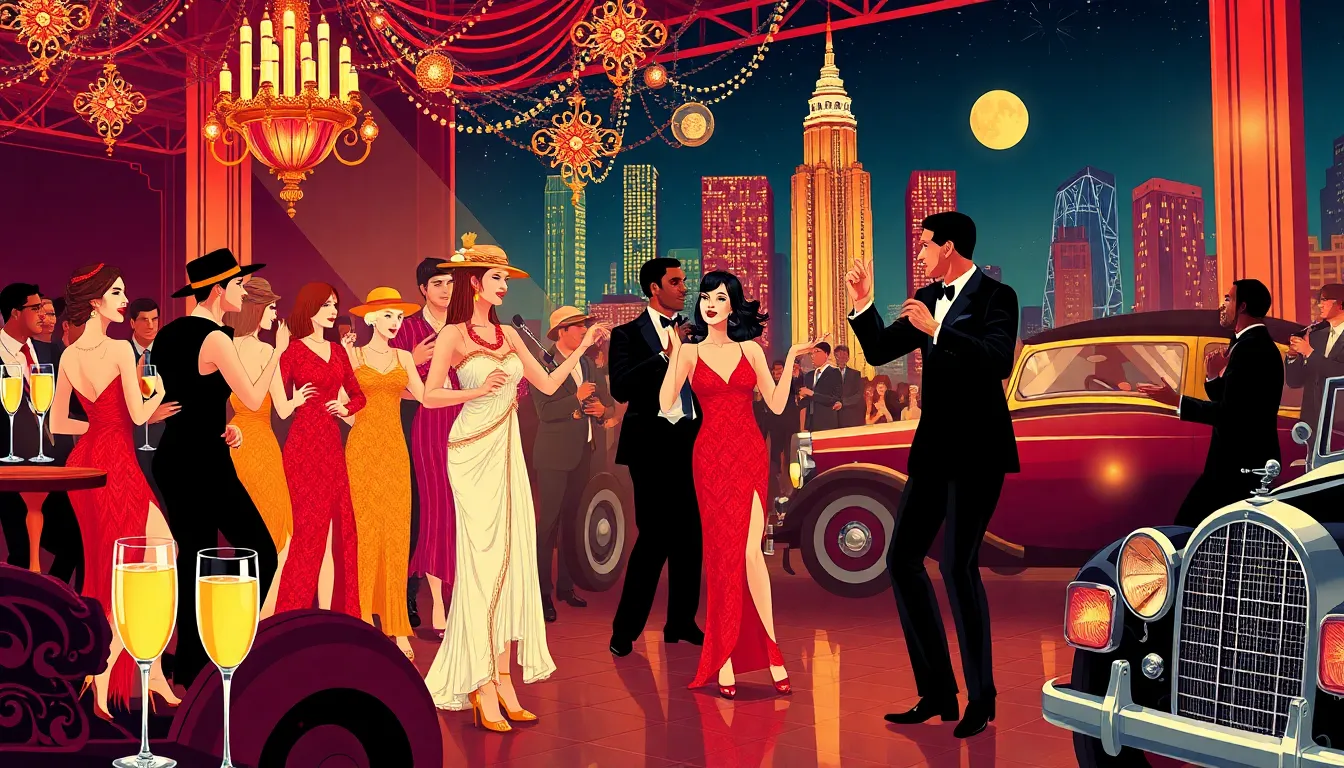The Best Fluffy Pancakes recipe you will fall in love with. Full of tips and tricks to help you make the best pancakes.

The Great Gatsby Drawing: Capture the Glamour and Mystery of the Roaring Twenties
In the vibrant world of literature, few characters shine as brightly as Jay Gatsby. But what if you could capture that sparkle in a drawing? The Great Gatsby drawing isn’t just a piece of art; it’s a window into the opulence and intrigue of the Roaring Twenties. Imagine sketching the lavish parties, the glimmering green light, and the enigmatic figure of Gatsby himself. It’s like time travel, but with fewer awkward conversations and more glitter.
The Great Gatsby Drawing Overview
The essence of Jay Gatsby captivates artists seeking to depict the opulence of the Roaring Twenties. Drawings inspired by Gatsby evoke images of lavish parties and intricate details in a vibrant world. Artists can express themes of wealth and mystery through bold lines and rich colors.
Drawings may feature the iconic green light, symbolizing Gatsby’s longing and unattainable dreams. Elements such as jazz music, vintage cars, and elegant flapper dresses enhance the mood, helping viewers feel the era’s excitement. The intricate nature of these elements fosters a deeper understanding of Gatsby’s character and ambitions.
Translating text to visual art allows for diverse interpretations. Gatsby’s enigmatic persona invites artists to explore multiple perspectives, revealing layers of complexity within his character. By capturing the subtleties in his expressions or the loneliness behind his grandeur, artists convey the emotional depth of the narrative.
Textures play a crucial role in these drawings, adding dimension to the imagery. Artists might incorporate a mix of smooth and rough textures to reflect the contrasting realities of Gatsby’s life. Each stroke provides insight into both the allure and the emptiness of wealth.
Context shapes the overall atmosphere of the drawing. Setting it against the backdrop of the Jazz Age creates an immersive landscape filled with hope and disillusionment. Surrounding characters, such as Daisy Buchanan, can further enrich the narrative, highlighting Gatsby’s relationships and aspirations.
Overall, the drawing serves as a portal to Gatsby’s world, revealing both the charm and the tragedy of his journey. Through visual representation, artists capture a moment in time and invite others to explore the intricate tapestry of his life.
The Artistic Style of The Great Gatsby Drawing

Artistic representations of The Great Gatsby capture the essence of a vibrant era. The drawings encapsulate the glamour and intrigue of the Roaring Twenties.
Influence of the Jazz Age
Jazz Age culture heavily influences the artistic style of Gatsby-inspired drawings. This period’s exuberance inspires a sense of movement in artworks. Artists often depict lively dance scenes, capturing the energy of jazz music. Lavish parties, with their dazzling figures and flapper dresses, create a backdrop that emphasizes decadence. Symbolic elements, such as champagne glasses and vintage automobiles, embody the lifestyle of the time. Color palettes featuring golds and rich greens reflect both opulence and aspiration. Inclusion of these aspects enables a deeper connection to the themes of ambition and longing.
Techniques Used by Artists
Artists employ various techniques to breathe life into their interpretations of Gatsby. Bold lines convey a sense of drama, while soft shading adds depth to characters. Many creators utilize contrasting textures to highlight the complexity of Gatsby’s experiences. Mixing smooth surfaces with rough edges illustrates the dichotomy between his glamorous exterior and inner turmoil. Layering colors not only enhances the visual appeal but also conveys emotional nuance. Artists often incorporate detailed features to emphasize significant symbols, such as the green light, representing Gatsby’s elusive dreams. These techniques crescendo into a captivating visual story that resonates with viewers.
Iconic Imagery in The Great Gatsby Drawing
Iconic imagery vividly illustrates themes in “The Great Gatsby.” Drawings inspired by the narrative capture the essence of the Roaring Twenties, highlighting symbols that convey deeper meanings.
Symbols and Their Meanings
Gatsby’s green light symbolizes unattainable dreams and hope. Artists depict this light in shades of green, contrasting with dark backgrounds to represent longing. Images of lavish parties embody the era’s opulence, showcasing elements like champagne glasses and glittering decor. Jazz instruments, such as saxophones and trumpets, evoke the music that defined the Jazz Age, illustrating moments of celebration and excess. These symbols collectively enhance visual storytelling, illustrating Gatsby’s pursuit of a future that remains just out of reach.
Character Representations
Character representations in Gatsby drawings evoke emotional depth. Jay Gatsby often appears surrounded by luxury, wearing tailored suits that signify wealth and ambition. Daisy Buchanan is frequently depicted in flowing dresses, embodying the grace and illusion of her character. Nick Carraway serves as an observer, captured in thoughtful poses that reflect his inner conflict. The placement of characters in dynamic postures can suggest their relationships and tensions, amplifying the complexity of the narrative. Artists use these representations to create a dialogue between characters, revealing their motivations and desires within the extravagant world they inhabit.
The Great Gatsby Drawing in Popular Culture
“The Great Gatsby” continues to inspire numerous forms of artistic expression in popular culture. Film adaptations frequently showcase Gatsby’s luxurious lifestyle through stunning visuals. These interpretations often bring attention to the extravagant parties and the iconic green light symbolizing unattainable dreams. Artists capture the era’s glamour, emphasizing the opulence that defined the Roaring Twenties.
Within modern art scenes, Gatsby-themed drawings resonate with audiences. Many artists explore the themes of wealth, longing, and the complexities of human relationships. Drawings featuring lavish parties and jazz music vividly illustrate the vibrancy of the time while communicating deeper emotional nuances.
In literature, graphic novels inspired by Gatsby provide fresh perspectives. These adaptations utilize visual storytelling techniques to engage readers, enhancing their connection to the narrative. By incorporating rich colors and intricate details, artists amplify Gatsby’s enigmatic persona and the emotional depth of his character.
Merchandise featuring Gatsby-inspired designs also permeates popular culture. Items such as clothing, prints, and home decor reflect the enduring appeal of the Jazz Age aesthetic. These products not only celebrate Gatsby’s world but also invite fans to incorporate elements of the story into their lives.
Drawings in various media, from watercolor to digital illustrations, highlight the adaptability of Gatsby’s story in contemporary settings. The timeless themes of aspiration and tragedy keep Gatsby relevant, cementing its status in art and culture. Each artistic representation fosters a unique dialogue about the human experience, inviting audiences to reflect on their dreams and desires.
Conclusion
The allure of Jay Gatsby’s character continues to inspire artists and audiences alike. Through drawing, the essence of the Roaring Twenties comes alive, offering a unique lens into Gatsby’s world of dreams and disillusionment. Each artwork serves as a visual narrative that captures the grandeur and complexity of his journey.
As artists explore Gatsby’s story, they invite viewers to reflect on their own aspirations and the universal themes of longing and ambition. This artistic expression not only honors Fitzgerald’s timeless narrative but also keeps the spirit of the Jazz Age vibrant in contemporary culture. The enduring fascination with Gatsby and his extravagant lifestyle ensures that his story will continue to resonate for generations to come.
